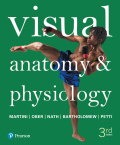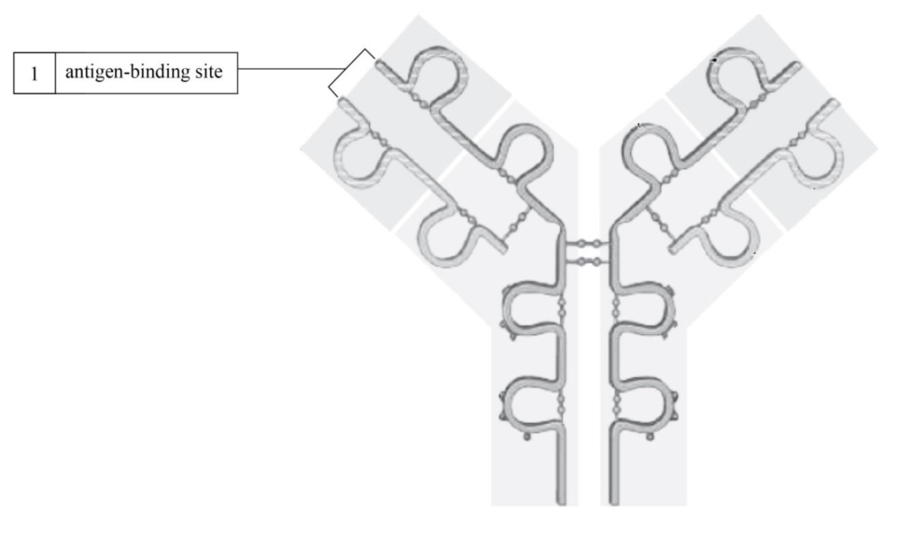
EBK VISUAL ANATOMY & PHYSIOLOGY
3rd Edition
ISBN: 9780134454658
Author: Petti
Publisher: PEARSON CUSTOM PUB.(CONSIGNMENT)
expand_more
expand_more
format_list_bulleted
Concept explainers
Question
Chapter 20, Problem 1CRQ
Summary Introduction
To label: Each part of the antibody molecule in the given diagram.
Introduction: An antibody is also called immunoglobulin. The plasma cells of the immune system produce antibodies to use them against pathogens invading the host body.
Expert Solution & Answer
Answer to Problem 1CRQ
Pictorial representation: Fig.1 represents an antibody molecule structure indicating the antigen-binding site.

Fig 1: Antigen binding site.
Explanation of Solution
The antibody is made up of two parallel pairs of polypeptide chains linked into a Y shape. The arms of the Y shaped antibody molecule contains the antigen-binding site. This site interacts with antigens in a specific manner.
Want to see more full solutions like this?
Subscribe now to access step-by-step solutions to millions of textbook problems written by subject matter experts!
Students have asked these similar questions
Give the terminal regression line equation and R or R2 value:
Give the x axis (name and units, if any) of the terminal line:
Give the y axis (name and units, if any) of the terminal line:
Give the first residual regression line equation and R or R2 value:
Give the x axis (name and units, if any) of the first residual line
: Give the y axis (name and units, if any) of the first residual line:
Give the second residual regression line equation and R or R2 value:
Give the x axis (name and units, if any) of the second residual line:
Give the y axis (name and units, if any) of the second residual line:
a) B1
Solution
b) B2
c)hybrid rate constant (λ1)
d)hybrid rate constant (λ2)
e) ka
f) t1/2,absorb
g) t1/2, dist
h) t1/2, elim
i)apparent central compartment volume (V1,app)
j) total AUC (short cut method)
k) apparent volume of distribution based on AUC (VAUC,app)
l)apparent clearance (CLapp)
m) absolute bioavailability of oral route (need AUCiv…
You inject morpholino oligonucleotides that inhibit the translation of follistatin, chordin, and noggin (FCN) at the 1 cell stage of a frog embryo.
What is the effect on neurulation in the resulting embryo?
Propose an experiment that would rescue an embryo injected with FCN morpholinos.
Participants will be asked to create a meme regarding a topic relevant to the department of Geography, Geomatics, and Environmental Studies.
Prompt: Using an online art style of your choice, please make a meme related to the study of Geography, Environment, or Geomatics.
Chapter 20 Solutions
EBK VISUAL ANATOMY & PHYSIOLOGY
Ch. 20.1 - Prob. 1RCh. 20.1 - Prob. 2RCh. 20.1 - Prob. 3RCh. 20.1 - Prob. 4RCh. 20.1 - Prob. 5RCh. 20.1 - Prob. 6RCh. 20.1 - Prob. 7RCh. 20.1 - Prob. 8RCh. 20.1 - Prob. 9RCh. 20.1 - Prob. 10R
Ch. 20.1 - C. Which cells are responsible for...Ch. 20.1 - Prob. 12RCh. 20.1 - Prob. 13RCh. 20.1 - Prob. 14RCh. 20.1 - Prob. 15RCh. 20.1 - Prob. 16RCh. 20.1 - Prob. 17RCh. 20.1 - Prob. 18RCh. 20.1 - Prob. 19RCh. 20.1 - Prob. 20RCh. 20.1 - Prob. 1LOCh. 20.1 - Prob. 2LOCh. 20.1 - Prob. 3LOCh. 20.1 - Prob. 4LOCh. 20.1 - Prob. 5LOCh. 20.1 - Prob. 6LOCh. 20.1 - Prob. 7LOCh. 20.1 - Prob. 1ICh. 20.1 - Prob. 1SRCh. 20.1 - Prob. 2SRCh. 20.1 - Prob. 3SRCh. 20.1 - Prob. 4SRCh. 20.1 - Prob. 5SRCh. 20.1 - Prob. 6SRCh. 20.1 - Prob. 7SRCh. 20.1 - Prob. 8SRCh. 20.1 - Prob. 9SRCh. 20.1 - Labeling: Label the structures of the lymphatic...Ch. 20.1 - Prob. 11SRCh. 20.1 - Prob. 12SRCh. 20.1 - Prob. 13SRCh. 20.1 - Prob. 14SRCh. 20.1 - Prob. 15SRCh. 20.1 - Prob. 16SRCh. 20.1 - Prob. 17SRCh. 20.1 - Prob. 18SRCh. 20.1 - Prob. 19SRCh. 20.1 - Prob. 20SRCh. 20.1 - Prob. 21SRCh. 20.1 - Prob. 22SRCh. 20.1 - Prob. 23SRCh. 20.1 - Prob. 24SRCh. 20.1 - Prob. 25SRCh. 20.1 - Prob. 26SRCh. 20.1 - Prob. 27SRCh. 20.1 - Matching: Match each lettered term with the most...Ch. 20.1 - Prob. 29SRCh. 20.1 - Prob. 30SRCh. 20.2 - Prob. 1RCh. 20.2 - Prob. 2RCh. 20.2 - Prob. 3RCh. 20.2 - Prob. 4RCh. 20.2 - Prob. 5RCh. 20.2 - B. How do NK cells detect cancer cells?
Ch. 20.2 - Prob. 7RCh. 20.2 - Prob. 8RCh. 20.2 - Prob. 9RCh. 20.2 - Prob. 10RCh. 20.2 - Prob. 11RCh. 20.2 - Prob. 12RCh. 20.2 - Prob. 1LOCh. 20.2 - Prob. 2LOCh. 20.2 - Prob. 3LOCh. 20.2 - Prob. 4LOCh. 20.2 - Prob. 5LOCh. 20.2 - Prob. 6LOCh. 20.2 - A child falls off her bike and skins her knee....Ch. 20.2 - Prob. 1SRCh. 20.2 - Prob. 2SRCh. 20.2 - Prob. 3SRCh. 20.2 - Prob. 4SRCh. 20.2 - Prob. 5SRCh. 20.2 - Prob. 6SRCh. 20.2 - Prob. 7SRCh. 20.2 - Prob. 8SRCh. 20.2 - Prob. 9SRCh. 20.2 - Prob. 10SRCh. 20.2 - Prob. 11SRCh. 20.2 - Prob. 12SRCh. 20.2 - Prob. 13SRCh. 20.2 - Prob. 14SRCh. 20.3 - Prob. 1RCh. 20.3 - Prob. 2RCh. 20.3 - Prob. 3RCh. 20.3 - Prob. 4RCh. 20.3 - Prob. 5RCh. 20.3 - Prob. 6RCh. 20.3 - Prob. 7RCh. 20.3 - Prob. 8RCh. 20.3 - Prob. 9RCh. 20.3 - Prob. 10RCh. 20.3 - Prob. 11RCh. 20.3 - Prob. 12RCh. 20.3 - Prob. 13RCh. 20.3 - Prob. 14RCh. 20.3 - Prob. 15RCh. 20.3 - Prob. 16RCh. 20.3 - Prob. 17RCh. 20.3 - Prob. 18RCh. 20.3 - Prob. 19RCh. 20.3 - Provide a plausible explanation for the increased...Ch. 20.3 - Prob. 1LOCh. 20.3 - Prob. 2LOCh. 20.3 - Prob. 3LOCh. 20.3 - Prob. 4LOCh. 20.3 - Prob. 5LOCh. 20.3 - Prob. 6LOCh. 20.3 - Prob. 7LOCh. 20.3 - Prob. 8LOCh. 20.3 - Prob. 9LOCh. 20.3 - Prob. 1ICh. 20.3 - Prob. 2ICh. 20.3 - Prob. 1SRCh. 20.3 - Prob. 2SRCh. 20.3 - Prob. 3SRCh. 20.3 - Prob. 4SRCh. 20.3 - Prob. 5SRCh. 20.3 - Prob. 6SRCh. 20.3 - Prob. 7SRCh. 20.3 - Prob. 8SRCh. 20.3 - Prob. 9SRCh. 20.3 - Prob. 10SRCh. 20.3 - Prob. 11SRCh. 20.3 - Prob. 12SRCh. 20.3 - Prob. 13SRCh. 20.3 - Prob. 14SRCh. 20 - Prob. 1CRQCh. 20 - Prob. 2CRQCh. 20 - Prob. 3CRQCh. 20 - Prob. 4CRQCh. 20 - Prob. 5CRQCh. 20 - Prob. 6CRQCh. 20 - Prob. 7CRQCh. 20 - True/False: Indicate whether each statement is...Ch. 20 - Prob. 9CRQCh. 20 - Prob. 10CRQCh. 20 - Prob. 11CRQCh. 20 - Prob. 12CRQCh. 20 - Prob. 13CRQCh. 20 - Prob. 14CRQCh. 20 - Prob. 15CRQCh. 20 - Prob. 16CRQCh. 20 - Prob. 17CRQCh. 20 - Prob. 18CRQCh. 20 - Prob. 19CRQCh. 20 - Prob. 20CRQCh. 20 - Prob. 21CRQCh. 20 - Prob. 22CRQCh. 20 - Prob. 23CRQCh. 20 - Prob. 1CICh. 20 - Prob. 2CICh. 20 - Prob. 3CICh. 20 - Prob. 4CICh. 20 - Prob. 5CICh. 20 - Prob. 6CICh. 20 - Prob. 7CI
Knowledge Booster
Learn more about
Need a deep-dive on the concept behind this application? Look no further. Learn more about this topic, biology and related others by exploring similar questions and additional content below.Similar questions
- Plekhg5 functions in bottle cell formation, and Shroom3 functions in neural plate closure, yet the phenotype of injecting mRNA of each into the animal pole of a fertilized egg is very similar. What is the phenotype, and why is the phenotype so similar? Is the phenotype going to be that there is a disruption of the formation of the neural tube for both of these because bottle cell formation is necessary for the neural plate to fold in forming the neural tube and Shroom3 is further needed to close the neural plate? So since both Plekhg5 and Shroom3 are used in forming the neural tube, injecting the mRNA will just lead to neural tube deformity?arrow_forwardWhat are some medical issues or health trends that may have a direct link to the idea of keeping fat out of diets?arrow_forwardwhat did charles darwin do in sciencearrow_forward
- fa How many different gametes, f₂ phenotypes and f₂ genotypes can potentially be produced from individuals of the following genotypes? 1) AaBb i) AaBB 11) AABSC- AA Bb Cc Dd EE Cal bsm nortubaarrow_forwardC MasteringHealth MasteringNu × session.healthandnutrition-mastering.pearson.com/myct/itemView?assignment ProblemID=17396416&attemptNo=1&offset=prevarrow_forward10. Your instructor will give you 2 amino acids during the activity session (video 2-7. A. First color all the polar and non-polar covalent bonds in the R groups of your 2 amino acids using the same colors as in #7. Do not color the bonds in the backbone of each amino acid. B. Next, color where all the hydrogen bonds, hydrophobic interactions and ionic bonds could occur in the R group of each amino acid. Use the same colors as in #7. Do not color the bonds in the backbone of each amino acid. C. Position the two amino acids on the page below in an orientation where the two R groups could bond together. Once you are satisfied, staple or tape the amino acids in place and label the bond that you formed between the two R groups. - Polar covalent Bond - Red - Non polar Covalent boND- yellow - Ionic BonD - PINK Hydrogen Bonn - Purple Hydrophobic interaction-green O=C-N H I. H HO H =O CH2 C-C-N HICK H HO H CH2 OH H₂N C = Oarrow_forward
- Find the dental formula and enter it in the following format: I3/3 C1/1 P4/4 M2/3 = 42 (this is not the correct number, just the correct format) Please be aware: the upper jaw is intact (all teeth are present). The bottom jaw/mandible is not intact. The front teeth should include 6 total rectangular teeth (3 on each side) and 2 total large triangular teeth (1 on each side).arrow_forward12. Calculate the area of a circle which has a radius of 1200 μm. Give your answer in mm² in scientific notation with the correct number of significant figures.arrow_forwardDescribe the image quality of the B.megaterium at 1000X before adding oil? What does adding oil do to the quality of the image?arrow_forward
arrow_back_ios
SEE MORE QUESTIONS
arrow_forward_ios
Recommended textbooks for you
 Human Anatomy & Physiology (11th Edition)BiologyISBN:9780134580999Author:Elaine N. Marieb, Katja N. HoehnPublisher:PEARSON
Human Anatomy & Physiology (11th Edition)BiologyISBN:9780134580999Author:Elaine N. Marieb, Katja N. HoehnPublisher:PEARSON Biology 2eBiologyISBN:9781947172517Author:Matthew Douglas, Jung Choi, Mary Ann ClarkPublisher:OpenStax
Biology 2eBiologyISBN:9781947172517Author:Matthew Douglas, Jung Choi, Mary Ann ClarkPublisher:OpenStax Anatomy & PhysiologyBiologyISBN:9781259398629Author:McKinley, Michael P., O'loughlin, Valerie Dean, Bidle, Theresa StouterPublisher:Mcgraw Hill Education,
Anatomy & PhysiologyBiologyISBN:9781259398629Author:McKinley, Michael P., O'loughlin, Valerie Dean, Bidle, Theresa StouterPublisher:Mcgraw Hill Education, Molecular Biology of the Cell (Sixth Edition)BiologyISBN:9780815344322Author:Bruce Alberts, Alexander D. Johnson, Julian Lewis, David Morgan, Martin Raff, Keith Roberts, Peter WalterPublisher:W. W. Norton & Company
Molecular Biology of the Cell (Sixth Edition)BiologyISBN:9780815344322Author:Bruce Alberts, Alexander D. Johnson, Julian Lewis, David Morgan, Martin Raff, Keith Roberts, Peter WalterPublisher:W. W. Norton & Company Laboratory Manual For Human Anatomy & PhysiologyBiologyISBN:9781260159363Author:Martin, Terry R., Prentice-craver, CynthiaPublisher:McGraw-Hill Publishing Co.
Laboratory Manual For Human Anatomy & PhysiologyBiologyISBN:9781260159363Author:Martin, Terry R., Prentice-craver, CynthiaPublisher:McGraw-Hill Publishing Co. Inquiry Into Life (16th Edition)BiologyISBN:9781260231700Author:Sylvia S. Mader, Michael WindelspechtPublisher:McGraw Hill Education
Inquiry Into Life (16th Edition)BiologyISBN:9781260231700Author:Sylvia S. Mader, Michael WindelspechtPublisher:McGraw Hill Education

Human Anatomy & Physiology (11th Edition)
Biology
ISBN:9780134580999
Author:Elaine N. Marieb, Katja N. Hoehn
Publisher:PEARSON

Biology 2e
Biology
ISBN:9781947172517
Author:Matthew Douglas, Jung Choi, Mary Ann Clark
Publisher:OpenStax

Anatomy & Physiology
Biology
ISBN:9781259398629
Author:McKinley, Michael P., O'loughlin, Valerie Dean, Bidle, Theresa Stouter
Publisher:Mcgraw Hill Education,

Molecular Biology of the Cell (Sixth Edition)
Biology
ISBN:9780815344322
Author:Bruce Alberts, Alexander D. Johnson, Julian Lewis, David Morgan, Martin Raff, Keith Roberts, Peter Walter
Publisher:W. W. Norton & Company

Laboratory Manual For Human Anatomy & Physiology
Biology
ISBN:9781260159363
Author:Martin, Terry R., Prentice-craver, Cynthia
Publisher:McGraw-Hill Publishing Co.

Inquiry Into Life (16th Edition)
Biology
ISBN:9781260231700
Author:Sylvia S. Mader, Michael Windelspecht
Publisher:McGraw Hill Education
Immune System and Immune Response Animation; Author: Medical Sciences Animations;https://www.youtube.com/watch?v=JDdbUBXPKc4;License: Standard YouTube License, CC-BY
Immune response: summary; Author: Dr Bhavsar Biology;https://www.youtube.com/watch?v=ADANgHkX4OY;License: Standard Youtube License